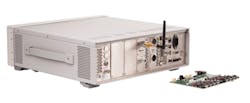Testing connected devices from RF to audio
As the Internet of Things in all its manifestations continues to roll out, developers will need a variety of test strategies to ensure low power consumption, suitable RF performance, and even audio quality for applications with voice input/output. The available tools for testing connected devices range from power supplies to vector signal transceivers, as described in our December print special report1 on the topic. Other applicable tools range from vector network analyzers to Bluetooth audio test systems.
Anritsu, for example, positions its VectorStar and ShockLine VNA product families for connected-device test. Steve Reyes, senior product manager at Anritsu, commented, “VectorStar is often chosen by R&D engineers because it provides them with the most accurate characterization of transistors used in connected devices, which in turn provides them the necessary data for the highest degree of device model accuracy. Accurate device characterization is often contingent upon wide frequency sweeps, well beyond the operating frequency range of the device, for best analysis results.”2
As noted in our December special report, Tektronix’s Keithley product line includes several instruments that can help engineers design low-power products. Robert Green, senior market development manager, said, “For the design engineer who selects low-power components and for the component engineer who characterizes and qualifies the components, we offer highly sensitive source-measure units. The new touchscreen 2450 source-measure unit can measure low currents to below pA levels, so that the current that the low-power components draw in their idle or sleep mode can be verified.”
He continued, “Once the optimum low-power components have been selected and incorporated into the product design, we offer precision DC power supplies to provide accurate, clean power. The Keithley Series 2280S power supplies provide 0.02% voltage setting accuracy and readback measurement, <1-mV rms noise, and four-wire remote sensing. These features are designed in to ensure that the desired voltage is accurately applied to the load even when the needed voltage is low, such as 4 V or less. The accurate voltage can help manufacturers of battery products accurately verify the low-battery shutoff voltage level. In addition, these power supplies have 10-nA DC current measurement resolution to measure small load currents.”
Specifically addressing the IoT, Green said, “Our Keithley products have gone even further to help the manufacturers of portable IoT products test their designs under the most realistic conditions. Tektronix has recently introduced the Keithley Model 2281S-20-6 precision DC power supply and battery simulator. This product is an enhancement to the Keithley Series 2280S precision power supplies. The new Model 2281S can dynamically simulate a battery’s output during the charge and discharge cycle.”
He explained that the output is based on a battery model that emulates the battery’s state of charge, open-circuit voltage, and internal resistance from 100% state of charge to 0% state of charge. “The simulator displays state-of-charge, amp-hour capacity, internal resistance, and open-circuit voltage,” he said. “In addition, the battery’s terminal output voltage and load current are also displayed. The display graphically shows the state of the battery at all times while it is powering a device. The simulator can build a model during a battery’s charge cycle, or a model can be imported based on a manufacturer’s specifications.”
Test data, he said, can be stored in the simulator, displayed graphically, or transferred to a PC using the LXI web page data logger. “Simulating the battery enables the designer to recreate specific battery conditions repeatedly so that results can be confirmed over a statistically significant sample of product,” he added. “Neither a standard power supply nor using actual batteries can provide the appropriate rigor for performing high-quality testing.”
Audio quality
Clearly, connected devices present test challenges ranging from DC power supplies to RF transmission and reception. There also may audio test challenges that engineers must address. To that end, Keysight Technologies recently introduced the enhanced U8903B audio analyzer with new Bluetooth audio-measurement capabilities. The Bluetooth option enables the U8903B to perform high-performance Bluetooth audio testing for R&D, quality assurance, and production in the consumer and professional audio and wireless communication industries.
Courtesy of Keysight Technologies
To easily monitor the quality of the Bluetooth link and troubleshoot connection issues, the U8903B comes with a received power indicator and bit error rate measurement. The received power indicator is a visual indication of the power strength of the device-under-test (DUT), and it gives users a quick and convenient way to check that the Bluetooth-RF link is strong enough. The bit error rate measurement shows the amount of error, given as a percentage, in the connection between the U8903B and the Bluetooth DUT. By monitoring changes in the bit error rate value, engineers can determine the causes of the link quality deterioration.
The U8903B audio analyzer also offers local loopback capability to provide fast and accurate testing of Bluetooth chipsets, modules, and devices. This feature allows the U8903B to simulate a Bluetooth transceiver to receive a Bluetooth audio signal from the DUT and loopback the same signal to the DUT. This ensures that both the uplink and downlink are tested at the same time, simplifying the test setup and reducing test time.
The U8903B is flexible and comes with configurable options. In addition to new Bluetooth audio measurement capabilities, the U8903B offers speech and voice quality measurements, expandable bandwidth, and digital audio interfaces, enabling engineers to accurately test wireless communication, component, and integrated circuit audio applications.
References
- Nelson, R., “Connected devices mandate RF, power test,” EE-Evaluation Engineering, December 2015, p. 12.
- Nelson, R., “VNAs support connected-device characterization,” EE-Evaluation Engineering Online, Dec. 8, 2015.
For more information

